THE TOMB OF YUSIF KUSEYIR OGLU
(1162)
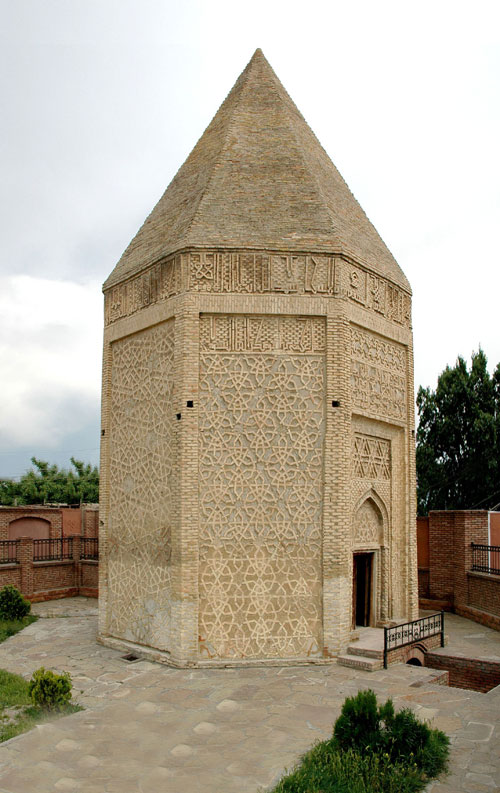
Remarkable urbanization and laudable evolution process of Nakhchivan dates go back to approximately 5 thousand years ago. During the 12th century, new architectural tendency led to the establishment of various architectural monuments was founded in Nakhchivan. Yusif Kuseyr oglu tomb as an exquisite model of these monuments was built by the founder of this tendency, Ajami Abubakroglu Nakhchivani in the south-eastern part of Nakhchivan city in 1162. Generally known as “Atababa gunbezi” the monument consists of an underground crypt and an over ground tomb. Erecting in an eight-sided shape from inside and outside, the tomb is covered by a pyramid-shaped dome. Yusif Kuseyr oglu tomb as one of the most valuable models of Turco-Islamic cultural heritage of Nakhchivan is the unique tower-shaped tomb that preserved its pyramid-shaped dome.
In accordance to the four-line inscription over the entrance to the monument, the tomb was built in commemoration of Yusif Kuseyroglu in 557 Islamic (Hijri) Calendar (1162 CE). The 15-17th verses of “Al-i Imran” Sura of Koran were engraved on the belt around the monument, as well as the sentence saying “The work of Ajami Abubakroglu Nakhchivani, the builder” was written down on the vault of the tomb.
Yusif Kuseyroglu is introduced with a several titles and epithets like “distinguished principal”, “believer”, “beauty of Islam” and “head of sheiks” in the inscription. The position of Yusif Kuseyroglu as a chief of the city was then quite prestigious one.
The outside of the tomb was renovated in 2001.
MOMINE KHATUN TOMB
(1186)
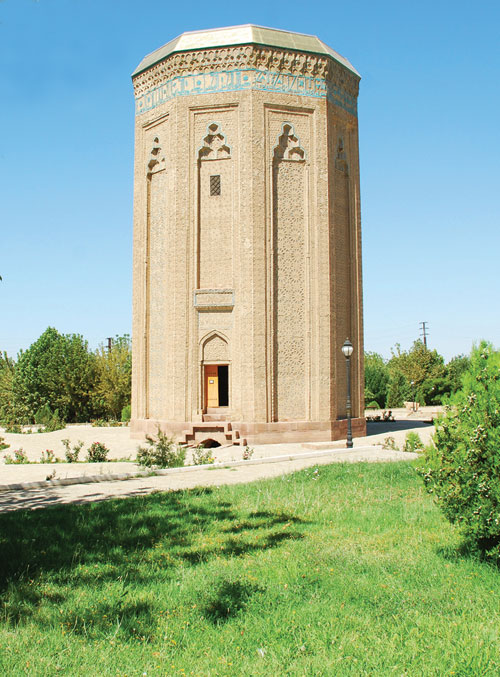
Momine Khatun Tomb is one of the most exquisite models of Turco-Islamic cultural monuments of Nakhchivan that was built by the distinguished architect Ajami Abubakroglu Nakhchivani and situated in Ajami seyrangah (the place for outings named after Ajami), in the city center of Nakhchivan. This monument consists of an underground crypt and an over ground tomb. The inside of the monument is round, but its outside is ten-sided shape. Previously, the height of the tomb was 35 meters high and under the influence of historical periods the tomb damaged and 25 meter high is left. The founder of the Great Atabeg State of Azerbaijan, Atabey Shamsaddin Eldaniz ordered to build this tomb in commemoration of his late wife, Momine Khatun who passed away in 1175. Meanwhile, soon after her death , he died life and constructional works of the tomb were completed during the reign of his son, Mahammad Jahan Pahlavan. Following the funeral of Momine Khatun, Atabey Shamsaddin Eldaniz and his son Mahammad Jahan Pahlavan were also entombed in the crypt of this historical monument.
Alongside the descriptive information about the tomb, sentences saying “All is temporal, except God, All is mortal, except Art”, as well as Mashallah (May God keep us from the evil eyes) were engraved on the inscription of the monument. In accordance to the information written on other inscriptions of the tomb, the constructional works of the monument were completed by Ajami Abubakroglu Nakhchivani in Muharram 582 Islamic (Hijri) Calendar (April 1186 CE).
Distinguished with its marvelous beauty, laudable compositional features and exquisite decorative ornaments, as well as considered masterpiece of medieval art of Azerbaijan, Momine Khatun Tomb is a globally important and magnificent monument. Therefore, distinguished art critic, professor V.M. Alpatov glorifies the monument by writing “thanks to its high sense of form, perfection of classical composition and comprehensive execution, one can not find such a magnificent monument even in Europe.”
Momine Khatun Tomb is an exquisite piece of art. Along the arches of the tomb, Yasin Sura of Koran was engraved as garnitures for turice, as well as the verse of Koran saying “All power Belongs to Almighty Allah” was written on the top of each arch. The 255th verse of Baqara Sura of Koran – Ayetel-kursu was engraved on a few meter height belt around the inside walls of the tomb.
There are four round medallions with a 1.5 meter diameter on the inside surface of the dome of the tomb. The word of “Mahammad” was repeated 8 times on the first medallion, the words of “Mahammad, Abu Bakr, Omar, Osman, Ali” were written on the 2nd and 4th medallions, the words of “Mahammad, Abu Bakr, Omar, Osman, Ali, Fatima, Hasan, Huseyn” were engraved on the 3rd medallion and the word of “Allah” was placed on the middle of the each medallion.
Highly appreciating Momine Khatun Tomb, National Leader of Azerbaijan, Heydar Aliyev stated: “It is a priceless historical monument. Momine Khatun Tomb truly proves the establishment of great architectural school and rich cultural heritage formed in Azerbaijan during the 12th century and The Middle Ages. Alongside its architectural value, this monument is the sign of ancient and steady statehood traditions of Azerbaijan.”
Thanks to the kind attention and care of the Chairman of the Supreme Assembly of Nakhchivan Autonomous Republic, restoration works were conducted in Momine Khatun Tomb in 2003.
NAKHCHIVAN BUZKHANA (ICE-HOUSE)
(XII-XIV centuries)
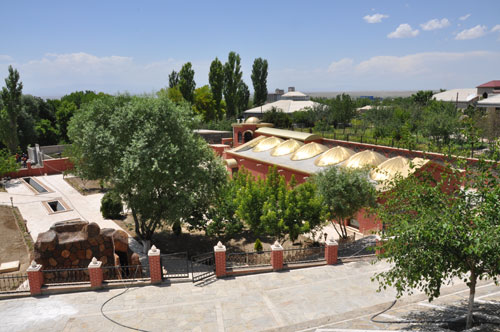
Being one of the unique samples of the Middle Ages Azerbaijani architecture the ice-house hold special place among the Turko-Islamic cultural monuments of Nakhchivan. One of these monuments distinguished with its architectural features, located in the southern part of Nakhchivan city near to Imamzadeh complex is Ice-house of XII-XIV centuries. This monument, being the largest one in the territory of Azerbaijan was built in the form of rectangular. The length of the building is 20 meters, the width 9 meters, the height 9.6 meters. The perfect solution of surface designed in a high quality, creation of light, vertical surface in dynamic construction scheme are the characteristic features of Nakhchivan Ice houses.
The high quality and perfect solution of Nakhchivan Ice- house proves its establishment in XII-XIV centuries, during the development of Nakhchivan architectural school. In ancient times, Ice houses have met the needs of population for ice during the hot summer. Nakhchivan Ice-house stopped functioning as the refrigerators became more popular in households.
Ice-house, being subject to strong erosion over time was restored in 2013 by the order of Chairman of Supreme Assembly of Nakhchivan Autonomous Republic.
KHAN PALACE
(XVIII century)
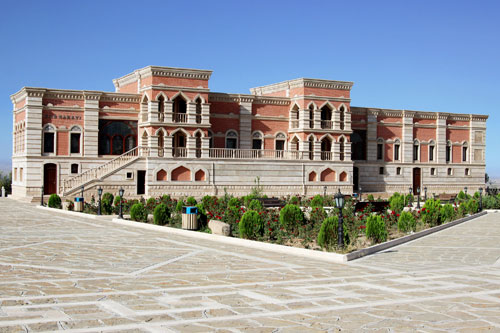
Turko-Islamic cultural monuments built in the territory of Nakhchivan Autonomous Republic include civil buildings, as well as palaces. One of these palaces is Khan Palace, the house of Nakhchivan khans. Khan Palace is located in “Khan hilly land” of Nakhchivan city. The Palace, having 3600 square metr area and distinguished with its architectural style was built facing the sunrise direction appropriate to the relief of the territory. The Palace was built by Kalbali Khan Kangarli, well-known statesman at the end of XVIII century. The palace built in Oriental architectural style was the house of Nakhchivan Khan’s up to the beginning of XX century.
The Khan Palace is two-storeyed. Before, the palace was consisted of two separate sections. The south section was considered for administrative affairs, as well as for receiving the senior raking guests, whereas the north section was aimed for the khan’s family to live in. The total area of the Khan palace is 382 square metr. The building was built of burnt bricks and the thickness of walls is approximately one meter. There are eight rooms in the ground floor, six rooms and two halls in the first floor. The building was heated by the means of two fire-places set in the walls.
Khan Palace was restored in 2010 by the order of Chairman of Supreme Assembly of Nakhchivan Autonomous Republic.
ZAVIYA – MADRASA BUILDING
(XVIII century)
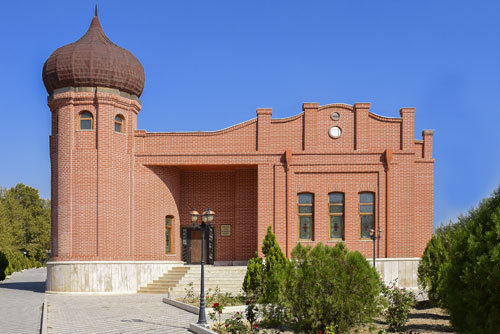
Muslim religious schools belonging to mystic sects, as well as Zaviya, buildings were built to meet needs for educated staff in Nakhchivan after the 7th century. Zaviya buildings were the places of worship and education. Therefore, Zaviya-madrasa buildings were built at that period of time. These special architectural models are preserved in Nakhchivan. Yet, unlike other Turco-Islamic cultural monuments of Nakhchivan, Zaviya-madrasa building stands out for its special design. Zaviya-madrasa building is situated in Zaviya Street, Nakhchivan city. The word “Zaviya” is translated from the Arabic language as “corner” and these buildings were used as centers of accommodation, worship and education in the Middle Ages.
Zaviya-madrasa building constructed in the 18th century seems to be a square-shaped form, but indeed it possesses a very complicated architectural structure. The building was based on a rostrum at 1 meter high on the ground. Its total area is 212 square meters. It is completely distinguished from other buildings in Nakhchivan in terms of its structure and the forms of its different parts.
In accordance to the order of the Chairman of the Supreme Assembly of Nakhchivan Autonomous Republic, Zaviya-madrasa building was thoroughly restored in 2008.
ORIENTAL BATH-HOUSE
(XVIII century)
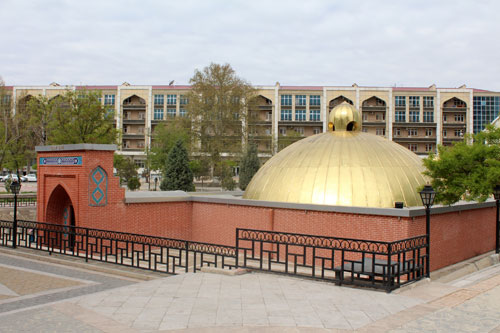
Bathrooms are the original models of Turco-Islamic cultural monuments. Oriental bath-house of Nakhchivan city is situated in the city center, in front of Tabriz Hotel, in the square of Dede-Gorqud. Indigenous people of Nakhchivan call this bath-house as “Bath-house of Ismayil khan” in honor of Ismayil khan from the dynasty of the khans of Nakhchivan. Oriental bath-house played an important role in the lives of native people as a place for bathing, cleanliness, as well as meetings, talks, rest and therapy.
The building of bath-house dated to the XVIII century, consists of entrance hall, service room, bathing room with a pond, storehouse and furnace. Its total area is 526 square meters. The bath-house is in an oblong shape in its plan. The building is made of burnt brick. The dressing room of the bath-house is an eight-sided shape. There are two transition ways to the bathroom. The pond was built in the center of the bathing room. The proof of a 108 square meter bathroom is covered by spherical dome.
The storehouse of the building joins to the bathroom. The hole of the storeroom was used to take water. Needs of the bath-house for water was provided through underground water supply. The furnace under the storeroom was served to heat the building. The heat was delivered to the rooms via underground pipes.
The bath-house was completely restored in 2005.
YENGIJA BATH-HOUSE
(XVIII century)
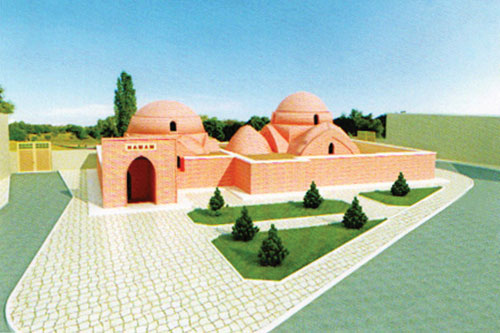
Samples of monuments coming to the modern time prove that bath-houses functioned in urban and rural areas of Nakhchivan Autonomous Republic in the past. Yengija bath-house is one of the exquisite models of Turco-Islamic cultural heritage of Nakhchivan. This ancient bath-house was built in the village of Yengija in Sharur district. According to the information given by the indigenous people, Yengija bath-house was constructed by the command of Tovuz khanim from Shahtakht in the XVIII century. The bath-house was used by the people of Yengija, as well as visitors from neighbouring villages.
The total area of Yengija bath-house is 650 square meters. The building of the bath-house is made of mortar and burnt bricks. The bath-house is a right-angled form and consists of two octagon halls and two subsidiary rooms joining them. The spherical domes, an entrance portal and other service rooms of the bath-house underwent a partial destruction, yet in good order.
The doors of the subsidiary rooms are situated between two halls and open to the bathing hall. The furnace of the bath-house is located in the South of the building. The bath-house used to be heated by means of hot air canals arranged under the floor. The building was lighted by means of a smoke duct placed in the center of the dome and little windows in the walls.
In accordance to the order of the Chairman of the Supreme Assembly of Nakhchivan Autonomous Republic, The bath-house was restored in 2017.
BUZKHANA IN JALILKEND (ICE-HOUSE)
(XIX century)
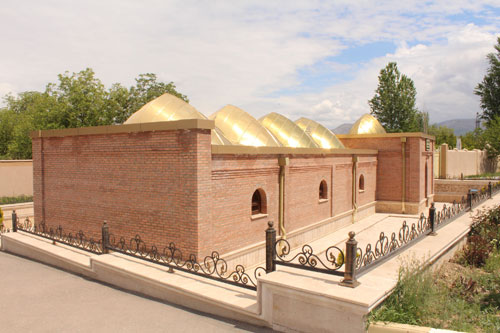
Medieval traditions of establishment of Turco-Islamic cultural monuments preserved for the future periods in Nakhchivan. The establishment of Jalilkend Buskhana built in the XIX century truly proves this tradition. This ice house is situated in Jalilkend village of Sharur district. The building is of square form and completed in a span form at the top. Entrance to the monument is from the South. The walls of the building were constructed of grey color hewed rock pieces. There were built square shaped pavements along the inside walls. There were built special rock stairs to go down the ice house.
According to the order of the Chairman of the Supreme Assembly of Nakhchivan Autonomous Republic, previously weathered ice house was restored in 2015.
ORDUBAD CITY ICE-HOUSE
(XIV century)

The ice-house built in Ordubad city in the XIV century is one the unique monumental models of medieval Turco-Islamic cultural heritage of Nakhchivan. This monument is situated in city center of Ordubad and considered the second oldest preserved ice-house of Nakhchivan.
The total area of the ice-house located near the Jame Mosque is 166 square meters and the area of the basement is 89.4 square meters. The ice-house is constructed of mortar and burnt bricks. The building consists of a big entrance room, stairs and basement where ice was made and stored.
In accordance to the information given by the researchers, the ice-house was built in the XIV century and was renovated in the XVIII century.
Thanks to the care of the Chairman of the Supreme Assembly of Nakhchivan Autonomous Republic, the ice-house was completely restored in 2014.
AZA BRIDGE
(XVI-XVII centuries)
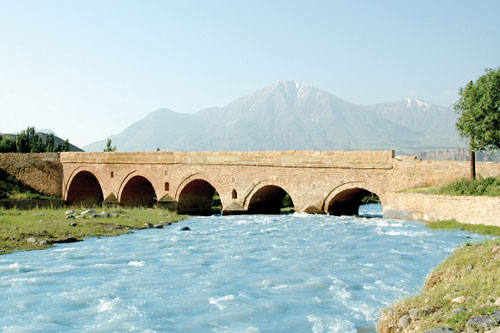
Bridges are the main parts of historical monuments belonging to the medieval Turco-Islamic cultural heritage of Nakhchivan. Aza Bridge is one of the bridges built during the reign of Safavid leader, Shah Abbas I (1587-1629). Therefore, this bridge is also called “The Bridge of Shah Abbas”.
The villages of Darkend and Aza of Ordubad district are connected via Aza Bridge over the Gilanchay River. The bridge was constructed of the reddish color ashlar local mountainous stone. The size of the bridge is 3.5 meters in width and 46 pagonometers in length. During the construction works the area was taken into consideration and as the arches vere built on the natural-bases, the interpans distance was fixed differently. In the North of the bridge, wave cutters were built in front of the spans.
Aza Bridge had a significantly important role in connecting Eastern countries, including China and India with the Black Sea countries and Europe along the Silk Road.
Since the strong floodings destroyed the western part of the Bridge at the end of the XX century, Aza Bridge was restored in 1997.
ORDUBAD GEYSARIYYE
(XVII century)

Geysariyye – one the Turco-Islamic monuments of Nakhchivan, was built in Ordubad city, the XVII century. Geysariyye is situated in market square, the city center of Ordubad. Geysariyye made remarkable contributions to trade due to being one of the indoor markets in the Middle Ages. Some belongings of the shahs – jewels, red precious stones were put on sale in Geysariyye. Therefore this monument was also called “Bazar of Shah”.
Total area of Geysariyye is 540 square meters. The monument consists of a hall center with a round dome covering its roof, very complicated four supporters holding the dome in the corners and the passages arranging between the supporters and side wall recesses. The roofs of the passages were covered by 16 small domes. The height of the monument, including central dome is 8.5 meters. Geysariyye – the unique model of Eastern Architecture has been functioning as History-Ethnography Museum of Ordubad district.
In accordance to the order of the Chairman of the Supreme Assembly of Nakhchivan Autonomous Republic, restoration
works were conducted in Geysariyye 2010.
ORDUBAD BATH-HOUSE
(XVIII-XIX centuries)
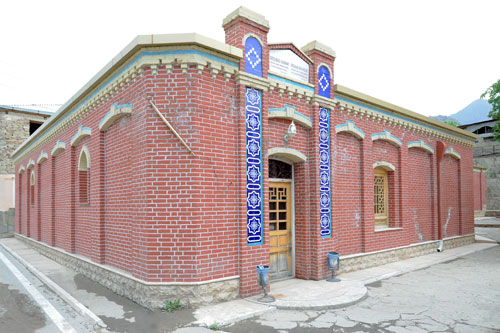
Ordubad bath-house is one the main Turco-Islamic cultural monuments of Nakhchivan. The bath-house was built in the city center, near the Jame Mosque of Ordubad during the XVIII-XIX centuries. Total area of the bath-house built in Eastern architectural design is 483 square meters. The building with one meter thick walls was constructed of burnt brick. The bath-house consists of a large vestibule, tea-house, cloakroom and bathing halls. There is an entrance from the rooms opening to the halls and furnace house. The cloakroom is square-shaped with sectioned corners, but the central salon is an octagon formed. The cloakroom is 7.4 meters high and its upper part is covered with a round-formed dome. The bathing hall is surrounded with deep spans of joined spans. Special raft stones were arranged inside the recesses for massaging. There is a round formed pond in the center of the hall. The diameter of the dome of bathing hall is 5.8 meters, but its height is 7.4 meters.
There is a hot water pond joined to the bathing hall in the east direction of the bath-house and under it there is a furnace house. The hole from the pond opening to the bathing-hall was used to take hot water. The water for the bath-house was taken from Garahovuz spring flowing nearby. Canals were placed under the bathing hall and rooms joined it for hot air circulation.
In accordance to the order of the Chairman of the Supreme Assembly of Nakhchivan Autonomous Republic, this historically important monument was restored in 2009.
GULUSTAN TOMB
(XII century)
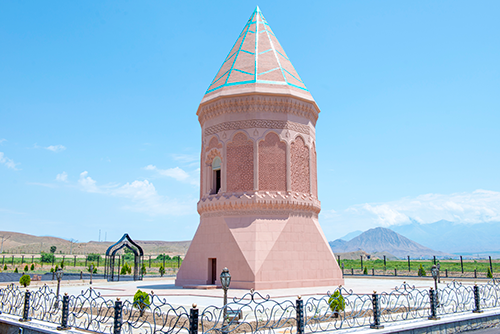
Gulustan tomb is one of the memorial monuments, which draws attention with its architectural structure, construction technique and specific features within the monuments of Turco-Islamic culture of Nakhchivan. The Gulustan tomb was constructed on the left bank of Araz River, about a kilometer east of Gulustan village of Julfa district. The originality of the Gulustan Tomb, which is built of dark red tufa, being one of the most beautiful and unique examples of the Nakhchivan architectural school, reflects the traditions of Ajami Abubakr Nakhchivani's creativity, as a unique artistic pearl with the construction technique, embroidery, appearance and architectural solution.
The Gulustan Tomb is sometimes referred as "Crossbow Dome". The mausoleum consists of two parts - a quarry and a tomb. The walls of the bridge were made of four rows of stones and formed as a polycondensation of the structure. In other
tombs, the barrow was built above the surface of the earth where it was placed under the ground. The shingle stele, which forms the lower part of the tomb, has a pyramid from outside and a cylindrical structure inside. The upper part consists of a twelwe-sided tower. The top camera of the tomb is a circle of 4.6 meters in diameter. Top of its flooded walls are gradually turning into a dome shaped ellipsis. The interior is decorated with fine patterns and ornaments.
Architectural ornaments are placed on the arches so that watchers always see different ornaments on adjacent surfaces. Ornamentation in the arches is only felt when looking closely. These patterns and ornaments are similar to ornaments in the mausoleum of Momuna Khatun, built in 1186 in Nakhchivan. Based on the geometric patterns, it is possible to say that the tomb was built in XII century.
The Gulustan tomb was restored by the Order of the Supreme Majlis of the Autonomous Republic of Nakhchivan on October 7, 2015.
KHANAGAH ARCHITECTURAL COMPLEX
(XII –XV centuries)

The mystic centers such as Khanagah architectural complex (XII-XV centuries) hold special places among the religious monuments built in the territory of Nakhchivan during the Middle Ages. This complex is situated in the north-east part of Khanagah village of Julfa district. The complex consists of tomb, mosque and other buildings. According to the inscription, the tomb which forms the basis of the complex was built by the architect Khaje Jamaladdin by order of Ulug Gutlug Lala bay. However, it dates go back to approximately XII century considering its architectural-constructive structure.
There is a grave in the tomb. According to the sources, Fazlullah Naimi, the founder of Hurifism, wide-spread in Azerbaijan in XIV century was buried in that grave. The inscription of tomb-mosque built close to Xanagah complex in the south says, tomb-mosque was built with Havva Badr Bika khatun’s efforts in 901(christianity1496) by Hijri calendar to the memory of Sheykh Haji-Lala Malik.
During the Middle ages the people belonging to different mystic sectors in Nakhchivan region lived and served in this complex.
The complex was reconstructed, the outside of the monument was renovated and the road was asphalted in 2005 by order of Chairman of Supreme Assembly of Nakhchivan Autonomous Republic. In 2016 the repair works were carried out outside of the monument.
GARABAGHLAR TOMB COMPLEX
(XII-XIV centuries)
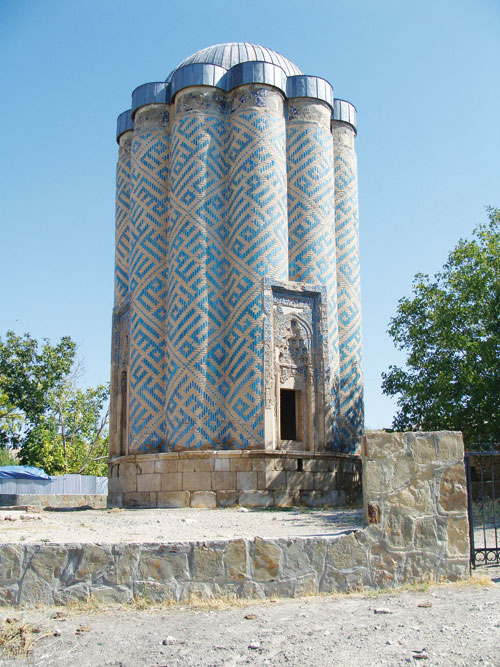
One of the grandiose samples of Turco-Islamic culture forming in the Middle Ages in the area of Nakhchivan is Garabaghlar Tomb Complex which relates to XII-XIV centuries. The Complex is considered to be the pearls of not only Azerbaijan, but also of Eastern architecture, in general.
The Complex is situated in Garabaghlar village, Kangarli region. It consists of a tomb and twin minarets head-span. By the lapse of time the twin minarets and a tomb belonging to XII-XIV centuries underwent demolition, its upper parts fell and the major part of the inscriptions crumbled. From the text of the inscription engraved on the twin minarets head-span it is supposed that construction of the complex was ordered by Jahan Guti Khatun. The name of one of the wives of Hulaku khan, the founder of Hulakus (Elkhanids) rulers was Gutuy khatun. Having a great influence in the palace Gutuy khatun owing to her mind and skill took part in the ruling of the state. Guti khatun mentioned in the inscription is the same woman who is remembered in the original sources in the form of Guti or Gutuy.
The date didn’t remain in the inscription. In the original sources the construction of the tomb was registered in XII century but the head-span joining minarets in XIV century. Belonging to tower shaped types of tomb of Azerbaijan Garabaghlar tomb having 12 halfcylindric projections, about 10 m diameter, reaching 16 m height at present-day condition has 4 head-spans. On the top of four head-spans was written the last part of the 16th verses of the “al-Mumin” sura of the Holy Koran
The surface of the tomb was decorated with kufic and naskh lettering inscriptions reminding geometric ornaments. All of these inscriptions are the Koran verses and religious sayings . The context of the inscriptions consists of turquoise glazed bricks arranged horizontally, unglazed red bricks placed vertically and prepared by means of bricks and repeatedly written in the rhombics “la-ilaha illallah Mahammadan Rasulallah” (There is no God but God and Mohammad is his Rasul (envoy).
The architectural features of the tomb, the writing techniques of the inscriptions, similiarities and other indications show that this monument was constructed by the architect of the Barda tomb Ahmad Ayyub oglu Hafiz Nakhchivani in the 30s of the XIV century.
Garabaghlar Tomb Complex was rebuilt by the 4 July 2016 Order of the Chairman of Supreme Assembly of Nakhchivan Autonomous Republic.


